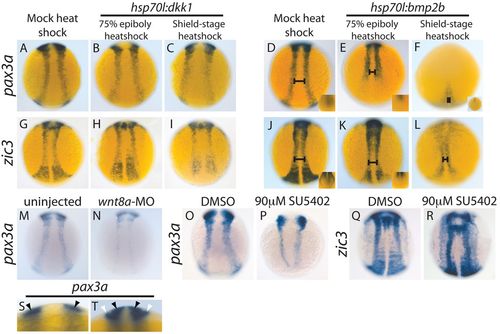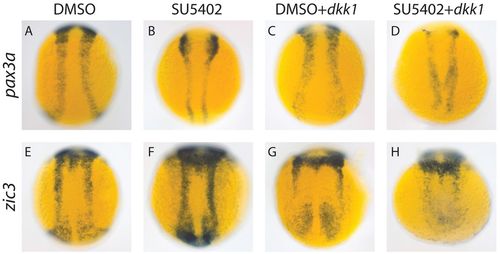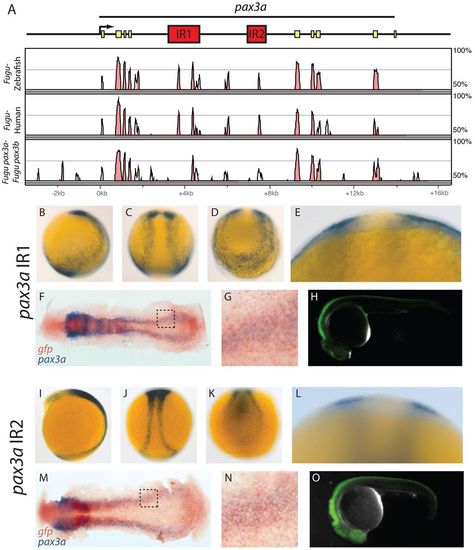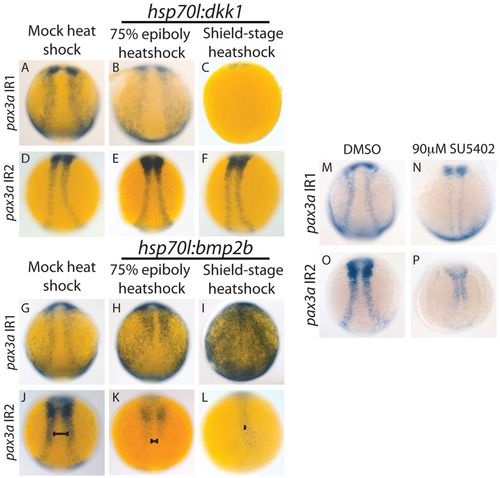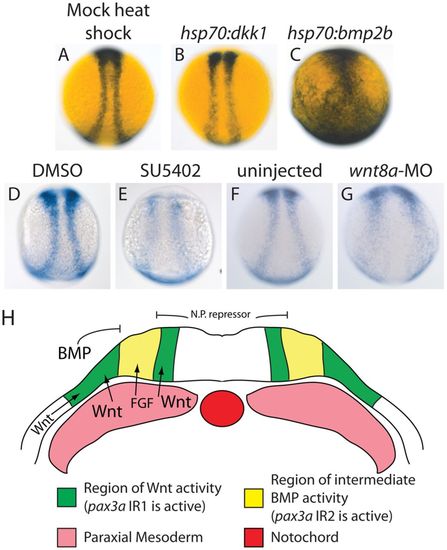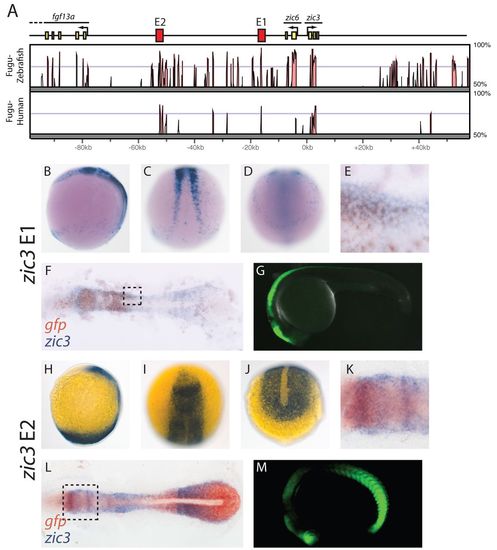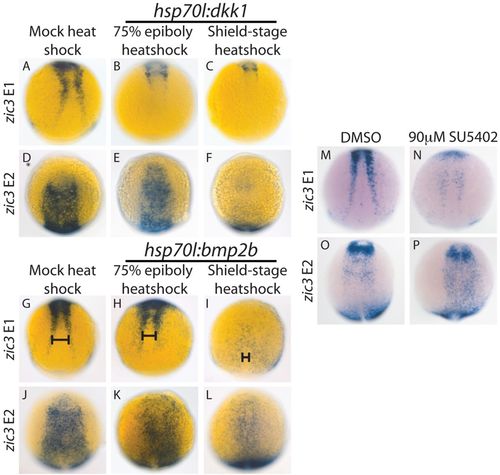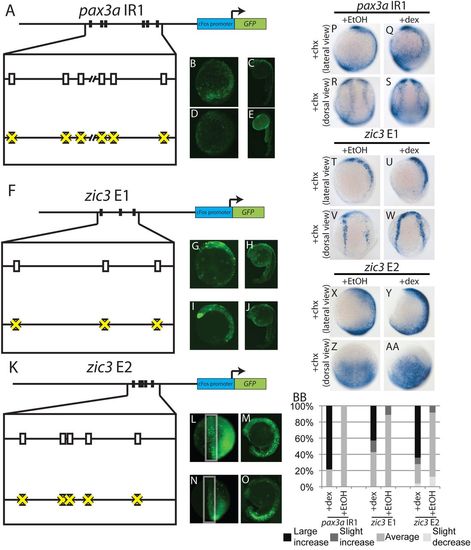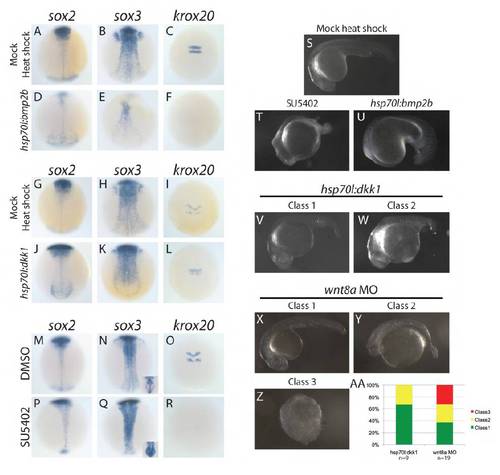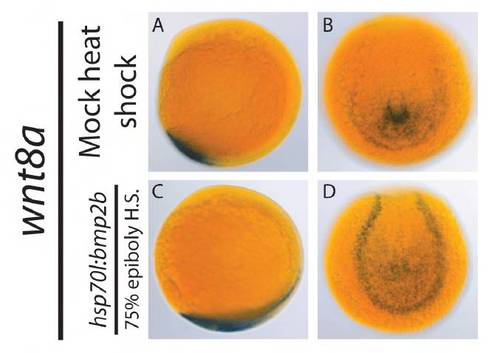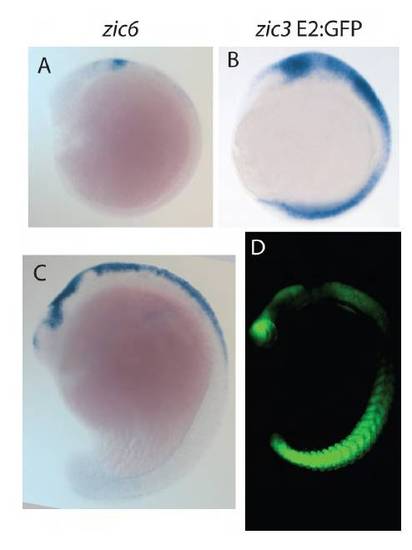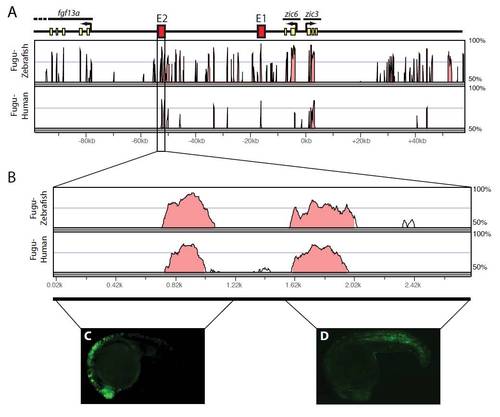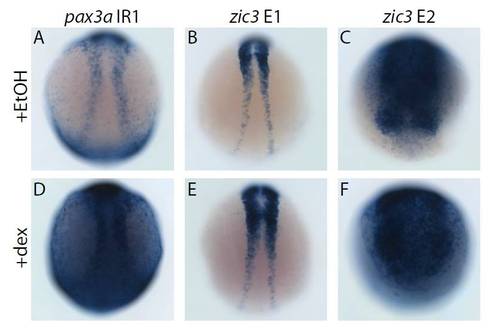- Title
-
BMP, Wnt and FGF signals are integrated through evolutionarily conserved enhancers to achieve robust expression of Pax3 and Zic genes at the zebrafish neural plate border
- Authors
- Garnett, A.T., Square, T.A., and Medeiros, D.M.
- Source
- Full text @ Development
|
BMP and Wnt signaling regulate pax3a and zic3, and FGF signaling regulates pax3a during late gastrulation. (A-C,G-I) pax3a and zic3 expression decreases upon heat shock-mediated dkk1 overexpression. pax3a and zic3 expression decreases slightly in hsp70l:dkk1 embryos heat shocked at 75% epiboly [pax3a, B versus A (81%, n=27); zic3, H versus G (93%, n=28)] and a shield stage heat shock leads to a greater decrease in expression [pax3a, C versus A (92%, n=49); zic3, I versus G (100%, n=33)]. (D-F,J-L) pax3a and zic3 expression in the NPB decreases and shifts medially upon heat shock-mediated bmp2b overexpression. A 75% epiboly heat shock leads to a loss of posterior NPB expression (E versus D and K versus J, insets) and a slight medial shift of the anterior NPB domain (D,E,J,K, bars) (pax3a, 100%, n=22; zic3, 94%, n=18). A shield stage heat shock leads to a drastic decrease in pax3a and zic3 expression throughout the anterior-posterior axis, and NPB expression shifts medially into a teardrop shape [pax3a, F versus D (100%, n=28); zic3, L versus J (100%, n=39)]. (M,N) Morpholino-mediated knockdown of wnt8a leads to a greater decrease in pax3a expression than does dkk1 overexpression [N versus M (90%, n=20)]. (O-R) Inhibition of FGF signaling by SU5402 treatment beginning at 7 hpf leads to a decrease in pax3a expression by 12 hpf (84%, n=44) (P versus O). The same SU5402 treatment does not decrease NPB zic3 expression (100%, n=27) (R versus Q). (S,T) Optical cross-sections allow the distinction between NPB and mesodermal pax3a expression. An optical cross-section of the trunk at ~12 hpf reveals pax3a expression in the ectoderm only (black arrowheads, S), whereas an optical cross-section slightly later reveals pax3a mRNA in the ectoderm (black arrowheads, T) and paraxial mesoderm (white arrowheads, T). The insets in D-F,J,K are posterior dorsal views, all other pictures are dorsal trunk views with anterior upwards. |
|
Wnt and FGF signaling play partially redundant roles in regulating NPB specifiers. (A-H) Embryos treated with SU5402 starting at 7 hpf exhibited decreased pax3a expression (100%, n=28) (B versus A), but no decrease in zic3 expression (100%, n=16) (F versus E). dkk1 overexpression induced by 7 hpf heat shock decreases expression of pax3a (100%, n=24) (C versus A) and zic3 (100%, n=16) (G versus E). When the Wnt and FGF signaling pathways are both attenuated with heat shock-induced dkk1 overexpression and SU5402 treatment starting at 7 hpf, pax3a and zic3 mRNA levels decrease more than when either pathway is knocked down alone [pax3a, D versus B,C (100%, n=24); zic3, H versus F,G (100%, n=17)]. All pictures are dorsal trunk views with anterior upwards. |
|
Two enhancers in pax3a intron 4 drive gene expression in the NPB and dorsal neural tube. (A) The Fugu pax3a locus is shown along with a Vista plot (Frazer et al., 2004; Mayor et al., 2000) of sequence identity between Fugu and zebrafish, Fugu and human, and Fugu pax3a and its paralog pax3b. Enhancer regions are shown in red and pax3a exons are shown in yellow. (B-O) GFP expression driven by IR1 (B-H) and IR2 (I-O) is shown as detected by in situ hybridization for embryos at 12 hpf (B-G,I-N) and by fluorescence at 24 hpf (H,O). Optical cross-sections through the trunk region confirm that IR1 and IR2 drive gene expression in the ectoderm (E,L) and double in situ hybridization for GFP (brown) and pax3a (purple) demonstrate that pax3a expression overlaps with the activity of IR1 and IR2 (F,G,M,N). G and N are higher magnification views of the areas outlined in F,M, respectively. B,H,I,O are lateral views; C,J are dorsal trunk views; D,K are posterior dorsal views. |
|
pax3a IR1 requires Wnt and FGF signaling, and pax3a IR2 requires BMP and FGF signaling for full activity. (A-F) dkk1 was overexpressed by heat shock in embryos with pax3a IR1:GFP or pax3a IR2:GFP. pax3a IR1 activity decreased with dkk1 overexpression induced with a 75% epiboly heatshock (100%, n=25) (B versus A) and was almost completely lost with a shield stage heat shock (100%, n=12) (C versus A). pax3a IR2:GFP activity did not decrease when dkk1-mCherry overexpression was induced by heat shock at 75% epiboly (92%, n=12) (E versus D) or shield stage (89%, n=18) (F versus D). (G-L) bmp2b was overexpressed by heat shock. pax3a IR1activity intensifies and expands into the neural plate and epidermis when bmp2b overexpression is induced with a 75% epiboly heat shock (93%, n=41) (H versus G) and heat shock at shield stage leads to an even greater activity increase and causes expansion into the entire neural plate (84%, n=19) (I versus G). pax3a IR2 activity decreases and shifts medially (J-L, bars) upon bmp2b induction by 75% epiboly heat shock (100%, n=33) (K versus J) and further decreases and shifts medially into a tear-drop shape with a shield-stage heat shock (100%, n=14) (L versus J). (M-P) SU5402 treatment (90 µM) beginning at 7 hpf causes a decrease in the activity of pax3a IR1 (94%, n=17) (N versus M) and pax3a IR2 (100%, n=25) (P versus O). All pictures are dorsal trunk views with anterior upwards. |
|
The combination of pax3a IR1 and IR2 is less susceptible to signaling perturbations than either enhancer alone. (A-G) GFP expression driven by a pax3a IR2+IR1 composite enhancer is shown under various treatments. dkk1-mCherry overexpression beginning with a shield stage heat shock mildly decreases enhancer activity (60%, n=42) (B versus A). bmp2b overexpression beginning with a shield stage heat shock causes increased enhancer activity, a shift medially in the trunk region and expansion in the posterior (87%, n=31) (C versus A). SU5402 treatment starting at 7 hpf drastically decreases the activity of the composite enhancer (100%, n=14) (E versus D). wnt8a-MO injection causes a more severe decrease in activity than dkk1 overexpression (80%, n=10) (G versus F). (H) A model for pax3a IR1 and IR2 activity. IR1 is activated by Wnt and FGF signaling in a wide band surrounding the NPB (green). IR2 activity is precisely positioned at the NPB by BMP signaling and a repressive neural plate factor and is amplified by FGF signaling (yellow). All pictures are dorsal trunk views with anterior upwards. |
|
Two zic3 enhancers drive gene expression in the NPB and dorsal neural tube. (A) The Fugu zic3/zic6 locus is shown along with a Vista plot of the level of sequence identity between Fugu, zebrafish and human zic3 loci. Enhancers are shown in red and exons are shown in yellow. (B-M) GFP expression driven by E1 (B-G) and E2 (H-M) is shown as detected by in situ hybridization for embryos at 12 hpf (B-F,H-L) and by GFP fluorescence at 24 hpf (G,M). Double in situ hybridization for GFP (brown) and zic3 (purple) demonstrate that zic3 expression overlaps with the activity of E1 and E2 (E,F,K,L). E,K are higher magnification views of the areas outlined in F,L, respectively. B,H,G,M are lateral views; D,J are posterior dorsal views; C is a trunk dorsal view; I is an anterior dorsal view. |
|
zic3 E1 is regulated by Wnt, BMP and FGF signaling, and zic3 E2 is regulated by Wnt and BMP signaling. (A-F) dkk1 was overexpressed by heat shock in embryos with zic3 E1:GFP or zic3 E2:GFP. dkk1 overexpression beginning with a 75% epiboly heat shock decreases zic3 E1 activity (100%, n=23) (B versus A) and slightly decreases zic3 E2 activity (88%, n=50) (E versus D). The NPB activity of both enhancers is almost completely lost, with dkk1 overexpression induced with a shield stage heat shock [E1, C versus A (100%, n=21); E2, F versus D (100%, n=55)]. (G-L) bmp2b was overexpressed by heat shock. zic3 E1 loses activity in the posterior NPB and shifts medially in the anterior (H, bar) upon bmp2b induction with 75% epiboly heat shock (93%, n=29) (H versus G). Shield-stage heat shock causes a dramatic reduction of E1 activity throughout and causes a drastic medial shift (I, bar) (96%, n=23) (I versus G). zic3 E2 activity does not change when bmp2b overexpression is induced with a 75% epiboly heat shock (79% with wild-type GFP level, n=38) (K versus J), but decreases with a shield-stage heat shock (100%, n=24) (L versus J). (M-P) SU5402 treatment beginning at 65% epiboly dramatically decreases zic3 E1 activity (100%, n=27) (N versus M), but not zic3 E2 activity (81% with wild-type GFP level, n=22) (P versus O). All E1 pictures are dorsal views of the trunk with anterior upwards; all E2 pictures are anterior dorsal views with anterior upwards. |
|
pax3a IR1 and zic3 E1 and E2 are probably direct targets of canonical Wnt signaling. (A-E) Mutating six putative Tcf/Lef-binding sites from pax3a IR1 (rectangles in A) decreases enhancer activity at 12 hpf (92%, n=36) (D versus B) and 24 hpf (100%, n=32) (E versus C). (F-J) Mutating three putative Tcf/Lef-binding sites (rectangles, F) does not affect zic3 E1 activity at 12 hpf (89%, 16 out of 18 with wild-type GFP levels) (I versus G) and 24 hpf (61%, 11 of 18 with wild-type GFP levels) (J versus H). (K-O) Mutating five putative Tcf/Lef-binding sites (rectangles, K) reduces zic3 E2 activity in the NPB at 12 hpf (87%, n=20) (N versus L) and the dorsal neural tube at 24 hpf (100%, n=40) (O versus M). (P-AA) Embryos containing pax3a IR1:GFP, zic3 E1:GFP or zic3 E2:GFP were injected with GR-Lef1-βcat mRNA. The activity of all three enhancers significantly increases with dexamethasone and cycloheximide treatment relative to ethanol and cycloheximide treatment [pax3a IR1, Q,S versus P,R (69%, P=7x107, n=16); zic3 E1, U,W versus T,V (57%, P=0.007, n=14); zic3 E2, Y,AA versus X,Z (73%, P=5×109, n=37)]. (BB) The distribution of GFP staining levels in embryos injected with GR-Lef1-βcat mRNA and treated with cycloheximide and dexamethasone or ethanol is shown for each enhancer. B-E,G-J,M,O,P,Q,T,U,X,Y are lateral views with dorsal towards the right; L,N,Z,AA are anterior-dorsal views with anterior upwards; R,S,V,W are dorsal trunk views with anterior upwards. |
|
The effects of heatshock-induced bmp2b and dkk1 overexpression, and SU5402 treatment on sox2, sox3 and krox20 expression and embryo phenotype. (A-F) Embryos carrying the hsp70l:bmp2b transgene were heatshocked at shield stage and fixed at 12hpf. bmp2b overexpression led to a decrease in the expression of sox2 (100%, n=8) (D versus A), sox3 (80%, n=10) (E versus B) and krox20 (100%, n=10) (F versus C). (G-L) Embryos carrying the hsp70l:dkk1 transgene were heatshocked at shield stage and fixed at 12 hpf. dkk1 overexpression led to a slight decrease in sox2 expression and a shortening of its posterior expression domain (54%, n=13) (J versus G), a slight decrease intensity of the anterior aspect of sox3 expression with little change in intensity in the posterior along with a shortening of its posterior expression domain (100%, n=12) (K versus H) and a decrease in the extent of krox20 expression (100%, n=17) (L versus I). (M-R) Embryos were treated with 90 μM SU5402 starting at 7 hpf and fixed at 12 hpf. SU5402 treatment led to a decrease in the extent and intensity of sox2 expression (P versus M) (100%, n=14) and an almost complete loss of krox20 expression (R versus O) (100%, n=16). SU5402 treatment caused an increase in the level of sox3 mRNA in the anterior neural plate, but the expression pattern was less organized (Q versus N, insets) (100%, n=16). (S-Z) The 18 hpf phenotypes of embryos undergoing various treatments are shown. The phenotype of embryos treated with SU5402 is similar to the fgf8a mutant phenotype (Brand et al., 1996), including a bulge in the midbrain primordium and defects in mesoderm development (T versus S). Embryos overexpressing bmp2b exhibit strong ventralization (U versus S). Embryos overexpressing dkk1 or injected with wnt8a MO exhibit anterior-posterior patterning defects consistent with a loss of Wnt signaling (V-Z versus S). We split embryos injected with wnt8a MO or overexpressing dkk1 into three classes of increasingly severe Wnt phenotypes (V-Z). (AA) The proportion of embryos from each treatment in each class is shown. In general, embryos injected with wnt8a MO had more severe phenotypes then those overexpressing dkk1 after a shieldstage heatshock. |
|
bmp2b overexpression leads to an upregulation of wnt8a. hsp70l:bmp2b embryos were heatshocked at 75% epiboly, fixed at six somites and stained for wnt8a mRNA. Embryos overexpressing bmp2b had an increased level of wnt8a expression in the tail ectoderm relative to mock heatshocked embryos (100%, 14 of 14) (C,D versus A,B). A and C are lateral views with dorsal to the right; B and D are posterior dorsal views. |
|
zic6 is expressed in a similar pattern to zic3 E2-driven GFP in the extoderm. (A,B) zic6 expression (A) and GFP expression in zic3 E2:GFP embryos (B) at 12 hpf. (C,D) zic6 expression (C) and GFP expression in zic3 E2:GFP embryos (D) at 24 hpf. All pictures are lateral views with dorsal towards the right. |
|
The neural plate border and mesodermal enhancer activities of zic3 E2 are separable. (A) The positions of zic3 E1 and E2 are shown with the level of sequence identity between Fugu and zebrafish and Fugu and human underneath. (B) The Vista plot comparing Fugu, zebrafish and human zic3 E2 regions indicates that there are two regions of high sequence identity within the enhancer. The 5′ and 3′ regions of zic3 E2 were separately placed upstream of the mouse Fos promoter and GFP, and their activities were analyzed in transiently transgenic embryos. (C,D) The 5′ region of E2 drives dorsal neural tube expression (C) and the 3′ region drives mesodermal GFP expression (D). C,D are lateral views with dorsal upwards and anterior towards the left. |
|
Constitutively active Lef1 activates pax3a IR1, zic3 E1 and zic3 E2 activity in the absence of cycloheximide. Embryos from the pax3a IR1, zic3 E1 and zic3 E2 transgenic lines were injected with glucocorticoid receptor-tagged Lef1-β-catenin and treated with ethanol (A-C) or dexamethasone (D-F) beginning at tailbud stage. pax3a IR1 exhibited an increase in enhancer activity upon induction of Lef1-β-catinin (D versus. A) (79%, n=19) as did zic3 E1 (E versus B) (45%, n=11) and E2 (F versus C) (100%, n=11). |

